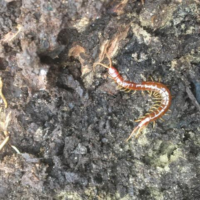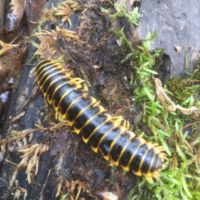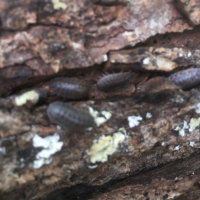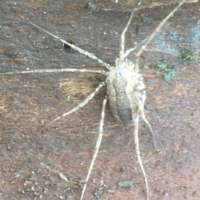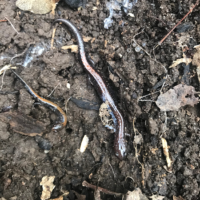Exploring the Forest Floor

Exploring the Forest Floor
When most people visit forests, they tend to look mostly upwards, into the trees looking for birds and squirrels, or off in the distance hoping to glimpse a deer or coyote. But if you want to have the best chance of seeing a lot of animals, you should look down. The forest floor habitat teems with small interesting animals that are easy to find and observe.
When you visit a natural place, you are in a habitat. A habitat is a place where an animal or plant lives and gets all the things it needs to survive and reproduce (food, water, shelter, and space). Habitats can be very big or very small. A bald eagle’s habitat would be thousands of acres in size and might contain several lakes and rivers, and many patches of forest and field. A spider’s habitat might be a single plant where it builds its web and spends its entire life. Larger habitats contain many ever-smaller habitats, nested within the larger ones like Russian dolls.
Very small habitats are called microhabitats. Two very different microhabitats can be within a very short distance of each other, and they are distinct because they have different characteristics such as moisture, temperature, or soil type.
The food of the forest floor habitat is provided largely from above. Trees make food all summer and then drop it in the fall. Outside of the annual leaf-fall, trees drop branches, leaves, fruits, and even whole trunks during other parts of the year. This tree “debris” (as we might think of it) is the energy that keeps the forest floor ecosystem going. Leaves are the main food of the forest floor, and branches, logs and soil also provide a lot of shelter.
One way to uncover the secrets of the forest floor is to roll logs, or move rocks or pieces of bark and see what is underneath. Always remember that as a visitor to the forest, you have a responsibility to be non-destructive. Most parks require that visitors stay on trails because if everyone rolled logs constantly, the habitat would soon be damaged. So if you do this, make sure you are allowed, and do it in moderation. When you overturn a log or rock, always carefully place it back just as you find it to preserve the qualities that made it a good place for something to live. And if you do find something living under there, be careful not to drop the log back onto it. Finally, don’t turn logs in cold weather, as you will cause animals that are seeking warmth to freeze to death. One way to expand your searching opportunities is to add habitats to your own backyard natural area by putting down plywood or sheet metal pieces (or logs, of course). These can later be searched, and you will see that animals will move in quite quickly.
When you move a log, notice that the microhabitat characteristics under the log make it a unique place. When it is very dry near the log, it will be moist under the log. If it is hot out, you’ll notice that it is much cooler under the log. Often, there are no leaves, which makes the soil accessible to the animals. If the log is decayed, there are hundreds of little hiding places. You will often see the white thread-like hyphae of a fungus. Fungi are decomposers, so they break down things like logs, releasing the nutrients back to the soil. As they break down the log, the log becomes food, and so do the fungi. Another great benefit to living under a log is protection from predators. If a small snake is living under a log, it is safe from bird predators (a bird can’t roll a log like you can).
So what are some common animals that you might find under a log? Or, put another way, what members of the forest floor community might use a log as their microhabitat?
- Perhaps the most common log-lovers around here are terrestrial isopods, usually called sowbugs, pillbugs, or woodlice. They are actually crustaceans, and breathe through gills. Therefore they require very moist conditions to survive.
- Another common and familiar animal seen on the forest floor are slugs. An interesting feature of slugs are their eyes that rest on stalks. The stalks can be retracted, so you might have to be patient to see them. When the slug gets used to your presence, the eyes usually pop up.
- Millipedes are many-legged tubes that bulldoze their way through decaying matter. There are many types of millipedes in Ohio, but they are all slow-moving eaters of decaying plants (and the fungi that is also involved in the process). Many types roll up their bodies to protect themselves when threatened.
- Centipedes have fewer legs than millipedes (one pair per segment rather than two pairs per segment in millipedes). But their legs are longer, and the centipedes are speedy predators. They have venomous fangs for paralyzing their prey, and bigger ones can bite a person. This would not be a serious injury, but most people would want to avoid handling centipedes.
- Spiders are another venomous predator attracted to the log by the prey that it might find there.
- Harvestmen, or daddy-long-legs are very common on the forest floor, and notice that they are not listed with the spiders. Harvestmen are arachnids, but they are not spiders. They lack the two-part body plan, venomous fangs, and silk-spinning features of spiders. Harvestmen are thought to be omnivorous, scavenging dead plants and animals, and maybe catching a slow-moving insect here and there.
- One of the most exciting things to see under logs are salamanders, such as a red-back salamander. This is one of the lungless woodland salamanders – they only breathe through their skin, so they must keep their skin moist in a humid microhabitat. Avoid handling salamanders to keep from damaging their skin.
- If you’re lucky, you might see a mammal such as a deer mouse or a vole under a log. They often build little nests out of leaves and hair. The nests are like little comforters to keep them warm in cold weather. You will often see chewed up acorns under logs, which are a sign of some small rodent.
- Finally, you might find snakes under logs. They are there to hunt for prey, to hide from their own predators, and maybe to keep cool on a hot day. One of the common log dwellers is the tiny ring-neck snake, which is a predator of earthworms and salamanders.
Exploring under logs and other covering objects is a great way to open up a new world of nature awareness. I hope you will give this a try in your neighborhood, but remember to be responsible and create as little impact as possible. Also, please never collect wild animals – they should always remain wild. A responsible explorer can learn a lot about the hidden world of the forest floor. I would love to see what you discovered in the microhabitats in your very own backyard – this could be on a tree, a small garden or even a patch of grass. Please feel free to send me your photos or questions to the email listed below: jmarshall@greenacres.org

